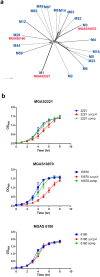A Multi-Serotype Approach Clarifies the Catabolite Control Protein A Regulon in the Major Human Pathogen Group A Streptococcus
- PMID: 27580596
- PMCID: PMC5007534
- DOI: 10.1038/srep32442
A Multi-Serotype Approach Clarifies the Catabolite Control Protein A Regulon in the Major Human Pathogen Group A Streptococcus
Abstract
Catabolite control protein A (CcpA) is a highly conserved, master regulator of carbon source utilization in gram-positive bacteria, but the CcpA regulon remains ill-defined. In this study we aimed to clarify the CcpA regulon by determining the impact of CcpA-inactivation on the virulence and transcriptome of three distinct serotypes of the major human pathogen Group A Streptococcus (GAS). CcpA-inactivation significantly decreased GAS virulence in a broad array of animal challenge models consistent with the idea that CcpA is critical to gram-positive bacterial pathogenesis. Via comparative transcriptomics, we established that the GAS CcpA core regulon is enriched for highly conserved CcpA binding motifs (i.e. cre sites). Conversely, strain-specific differences in the CcpA transcriptome seems to consist primarily of affected secondary networks. Refinement of cre site composition via analysis of the core regulon facilitated development of a modified cre consensus that shows promise for improved prediction of CcpA targets in other medically relevant gram-positive pathogens.
Figures






Similar articles
-
Genome-wide analysis of in vivo CcpA binding with and without its key co-factor HPr in the major human pathogen group A Streptococcus.Mol Microbiol. 2021 Jun;115(6):1207-1228. doi: 10.1111/mmi.14667. Epub 2020 Dec 29. Mol Microbiol. 2021. PMID: 33325565 Free PMC article.
-
The catabolite control protein CcpA binds to Pmga and influences expression of the virulence regulator Mga in the Group A streptococcus.J Bacteriol. 2007 Dec;189(23):8405-16. doi: 10.1128/JB.01038-07. Epub 2007 Sep 28. J Bacteriol. 2007. PMID: 17905980 Free PMC article.
-
CcpA-mediated repression of streptolysin S expression and virulence in the group A streptococcus.Infect Immun. 2008 Aug;76(8):3451-63. doi: 10.1128/IAI.00343-08. Epub 2008 May 19. Infect Immun. 2008. PMID: 18490461 Free PMC article.
-
The Mga virulence regulon: infection where the grass is greener.Mol Microbiol. 2007 Dec;66(5):1056-65. doi: 10.1111/j.1365-2958.2007.06006.x. Mol Microbiol. 2007. PMID: 18001346 Review.
-
P-Ser-HPr--a link between carbon metabolism and the virulence of some pathogenic bacteria.Biochim Biophys Acta. 2005 Dec 30;1754(1-2):118-25. doi: 10.1016/j.bbapap.2005.07.029. Epub 2005 Sep 12. Biochim Biophys Acta. 2005. PMID: 16182622 Review.
Cited by
-
Elucidation of independently modulated genes in Streptococcus pyogenes reveals carbon sources that control its expression of hemolytic toxins.mSystems. 2023 Jun 29;8(3):e0024723. doi: 10.1128/msystems.00247-23. Epub 2023 Jun 6. mSystems. 2023. PMID: 37278526 Free PMC article.
-
Functional analysis of the role of CcpA in Lactobacillus plantarum grown on fructooligosaccharides or glucose: a transcriptomic perspective.Microb Cell Fact. 2018 Dec 28;17(1):201. doi: 10.1186/s12934-018-1050-4. Microb Cell Fact. 2018. PMID: 30593274 Free PMC article.
-
Identification of distinct impacts of CovS inactivation on the transcriptome of acapsular group A streptococci.mSystems. 2023 Aug 31;8(4):e0022723. doi: 10.1128/msystems.00227-23. Epub 2023 Jun 26. mSystems. 2023. PMID: 37358280 Free PMC article.
-
Integration of Biological Networks for Acidithiobacillus thiooxidans Describes a Modular Gene Regulatory Organization of Bioleaching Pathways.Front Mol Biosci. 2020 Jan 10;6:155. doi: 10.3389/fmolb.2019.00155. eCollection 2019. Front Mol Biosci. 2020. PMID: 31998751 Free PMC article.
-
The Role of Regulator Catabolite Control Protein A (CcpA) in Streptococcus agalactiae Physiology and Stress Response.Microbiol Spectr. 2022 Dec 21;10(6):e0208022. doi: 10.1128/spectrum.02080-22. Epub 2022 Oct 20. Microbiol Spectr. 2022. PMID: 36264242 Free PMC article.
References
-
- Eisenreich W., Dandekar T., Heesemann J. & Goebel W. Carbon metabolism of intracellular bacterial pathogens and possible links to virulence. Nat Rev Microbiol 8, 401–412 (2010). - PubMed
Publication types
MeSH terms
Substances
Grants and funding
LinkOut - more resources
Full Text Sources
Other Literature Sources
Molecular Biology Databases

